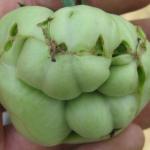Tomato, Cat Facing
Tomato catfacing is a physiological disorder of field and greenhouse tomatoes. This disorder has not been extensively researched and is not fully understood. Incidence of catfacing can increase chances of fruit becoming infected via the rough blossom scar by black mold rot, a disease caused by several different fungi, under certain environmental conditions.
Identification
A tomato is considered “catfaced” if the blossom scar is enlarged or perforated. Often times, the fruit becomes extremely misshapen, but fruit distortion is not necessary to classify it as catfaced.
Causes
Little research has been done on tomato catfacing, and the causes of the disorder are not fully understood. Cold temperatures during flowering has been shown to increase incidence of catfacing, as have extreme fluctuations in night and day temperature. Under some conditions, pruning and high nitrogen levels can increase incidence of the disorder. Additionally, damage from thrips to the side of the pistil of flowers can cause catfacing.
Management
- Avoid excessive pruning
- Avoid excessive nitrogen fertilization
- Avoid low greenhouse temperatures for both greenhouse tomatoes and transplants. Don't plant into high tunnels too early if you're not able to heat them.
- Use cultivars that are less prone to catfacing. Heirloom varieties tend to be more prone to catfacing than non-heirloom varieties.
--Adapted by G. Higgins, September 2016, from the Compendium of Tomato Diseases and Pests, 2nd ed, eds, J.B. Jones, T.A. Zitter, T.M. Momol, and S.A. Miller
The Center for Agriculture, Food and the Environment and UMass Extension are equal opportunity providers and employers, United States Department of Agriculture cooperating. Contact your local Extension office for information on disability accommodations. Contact the State Center Director’s Office if you have concerns related to discrimination, 413-545-4800 or see ag.umass.edu/civil-rights-information.

